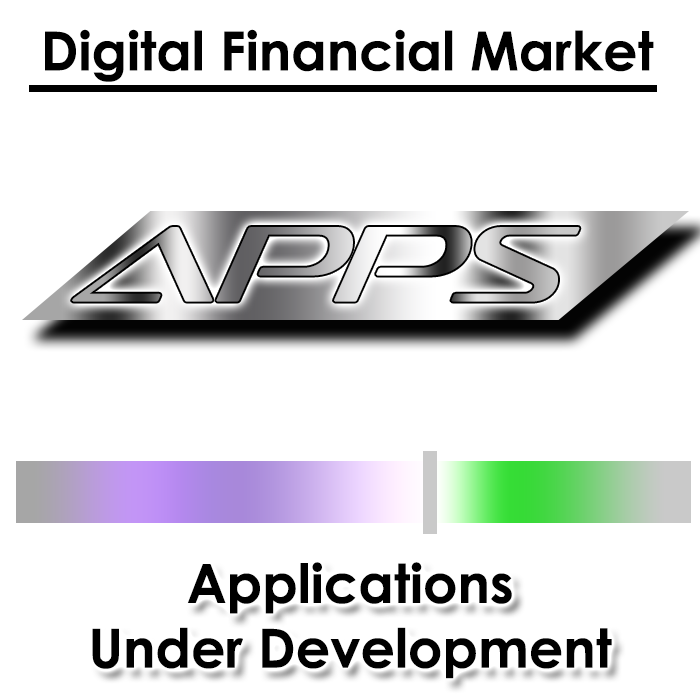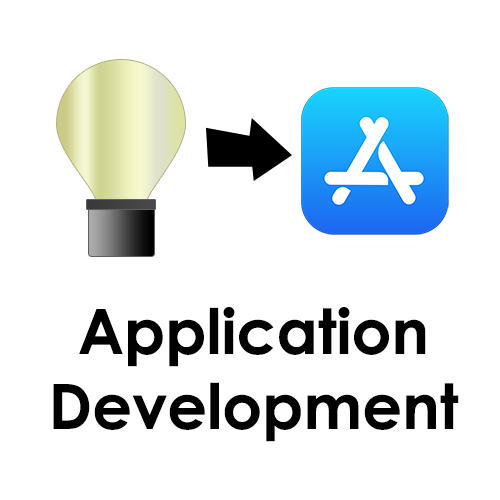We present our insights into the world of Application Development for modern devices. With useful information on the stages of AppDev and iOS Applications.
Helpful Steps to Creating an App
Creating an application for modern devices includes many steps for a App Developer. The field of Application Development (called AppDev for short) involves some technical skills, so we want to make the path to your new app easier through some step by step instructions.
Before Beginning: What Is Your Vision for an Application?
Our modern lives are constantly asking us to download the latest App, so it is important to consider what value proposition our new application may have.
Has the idea been done before? Are there major competitors? Would users want to download your App, or would users find bigger brand Apps more appealing?
Your personal vision and use case for your application will be the force that creates a full scale application. Any application that you make available across the internet is a launchpad for you or your business.
Highly Competitive Apps vs. Lower Competition
In the world of application development, there are many fields and uses for an application that may already have competition. Don’t let it discourage you, even apps and websites like Facebook became more popular than previous competitor MySpace only because it had a different interface.
Examples of High Competition Apps:
- Finance, Word Processors, Notes apps
- Health & Fitness
- Social Media, Streaming, Video apps
- Video Games
Examples of Low Competition Apps:
- Niche Applications
- Specified Tools (ex. audio noise canceller app)
- Apps that you might search for (ex. queries such as “EV cars releasing soon”)
- New uses for a Phone Application
There are many nuances to picking the right app to develop, but be creative! Combining certain features, providing an innovative approach, or even just creating better graphics and interfaces can help your App stand out against competitors.
Remember that App Development is very time intensive, so make sure you are passionate about your upcoming project! Patience and persistence wins.
Building An Application
App Dev: Native Apps vs. Cross Web Apps
Modern applications can vary in form, however they usually break down to either a Native Application like an iOS App, or a Cross Web App, which can take many shapes. The easiest way to approach which app development path to pursue is to reflect on the use and purpose of your application.
Cross Web App Development
Cross web apps have a wide variety of use cases and can be made to handle some powerful applications. They can be as small as an interactive webpage or as complex as a live database analyzer, and the positives are cross compatibility with some cloud deployment advantages.
Applications that have cross web structures can be built across multiple platforms, have varying ways of storing and sending data, and prevent single-points-of-failure (such as errors crashing the app).
An example of a cross web App would be a cryptocurrency application that allows users to connect their cryptocurrency wallets across a Laptop, Tablet, or Mobile Phone through the same webpage.
Native App Development
Native apps refers to apps built specifically for a device, for example iPhone has native iOS apps that are coded in the programming language Swift, or C++. Native apps have the disadvantage of being platform exclusive, unless built on a compatible app building software, which can be costly.
The advantage of Native apps is a crystal clear connection to your customer or audience. The popularity of apps available for iPhone creates huge brand recognition, customer loyalty, and extends the reach of your platform. Some apps that are very niche do not even need a marketing campaign because the App Store offers such a vast search volume for new apps daily.
Both Native & Cross Web Apps
Keep in mind that a determined developer is capable of pursuing both a Native and a cross web app. Examples on a small scale include combining services of many larger business and retailers which offer both shopping apps and integrated websites.
When deployed properly, they can work well together across platforms, such as embedding Shopify or YouTube Videos. However, many more complex applications can be quite pricey as they can have costs in proportion to their cloud data usage and/or functions.
Server hosting, databasing, and cloud infrastructure becomes more important the integrations of both a native app and cross web app may take more bandwidth. You want to keep your apps and websites online as possible, and plan for downtimes.
To take on more advanced website, front-end, back-end, and and database-building, and AppDev topics and careers, you may want to educate yourself in courses for Cloud Experts for Microsoft Azure, Google Cloud, or Amazon Web Services.
Application Development
AppDev Requirements
- Creativity and Vision
- A Lot of Determination
- Technical Programming Skills, or a Budget to Hire Developers
Keep in mind that no prior experience in programming or coding is required. Anyone can begin the path to Application Development with different approaches, such as using app building tools, graphic design, or even skills drawn from blogging.
We also encourage that it is totally possible to create your own app for free using only your Mac, personal determination, and the wealth of free resources available online. We will be looking into a further example by showing you some simple steps of iOS App Development.
iOS Application Development: Steps to Take
Developing an app for iOS can be a complex process, but it can also be a rewarding one. Here is a general overview of the steps involved in developing an app for iOS:
- Define your app’s purpose and features: Start by determining what your app will do and what features it will have. This will help you focus your development efforts and ensure that your app meets the needs of your target audience.
- Design the User Interface: Create wireframes and mockups of your app’s user interface to visualize how it will look and function. This will help you get feedback on your design before you start building the app.
- Develop the App: Use a programming language such as Swift to write the code that powers your app. You can use tools such as Xcode to help you build and test your app.
- Test the App: Thoroughly test your app to ensure that it is stable, reliable, and user-friendly. This may involve beta testing with a small group of users to get feedback on the app’s performance and usability.
- Submit the app to the App Store: When your app is ready to be released, you’ll need to submit it to the App Store for review. Apple will review your app to ensure that it meets their guidelines and standards.
- Promote and Update your App: Once your app is approved and available on the App Store, you’ll need to promote it to attract users and keep them engaged. You should also plan to release updates to your app to fix bugs, add new features, and improve performance.
The Stages of Application Development
- Stage 1: Define & Design
- Stage 2: Develop & Test
- Stage 3: Deploy & Launch
Stage 1: Design Your App
The first step from taking your new idea is to Design, Mock-up, and turn your idea into a visual that can be a framework for your to build around. A simple Slideshow or Doc file is a great way to start putting ideas down.
You can choose to outsource any layer of AppDev and Design, but you can only accurately craft your vision if you can communicate it! Even drafting a diagram, interface sketch, or a goal timeline are all essential to turning a business plan into a usable App.
Stage 2: Develop Your App
Using an app builder or IDE, you can hard code the framework for your applications functions, the most common is the Apple Development kit called Xcode. There are alternatives to create apps, such as PowerApps, but they don’t always offer the ground up skillset necessary to maintain an app ecosystem.
Tools Needed To Develop An iOS App
- A Mac Computer
- Xcode
For developing an iOS Application the bare minimum is a Mac Computer that can update to the latest MacOS and Xcode versions. Staying updated on your apps allows your dev tools to be up to date with Apples latest products, and is required for publishing Apps to the App Store.
Other tools that are very useful in testing are any recent iPhones (11, 12, 13), iPads, or other iOS devices like the iPod Touch. These are not required, but if you have any lying around, you can download Apple’s Test Flight App and try running your prototype App through your devices to check for compatibility errors, find crashes, and test for bugs.
This process may be lengthy and require many hours of research and learning, but after getting some hard-coding into a functional iOS app to be tested on a simulator or your own iPhone, the feeling of a successful build becomes incredibly rewarding.
Stage 3: Deploy & Launch!
After enduring the process of refining your code into a functional application, you may want to consider Apple’s checklist for App publications. This means following their content guidelines, uploading a resilient crash-free Application, and purchasing Apple’s Developer License.
After submitting your iOS application for review, your App will be reviewed by Apple’s Product teams for final approval. Apple has an extensive Developer Forum available on this topic.
Our Application Developments
Multiple Projects In Progress
The Digital Financial Market is developing our own applications across the web. Our software team is building some of our baseline products, including our New Hybrid Search Engine, and cross website interfacing.

Our team members are working steadily to improve our tools and implement a cross-web application through our website. With the contributions made by our software engineering team, we have also anticipated more platform compatibility through the creation of an iOS App.
Our Upcoming Applications
- Continuous Cross Web Website App/Interface Improvements
- An iOS Application of our tools
- More Website tools and developments
Our Goals with Applications
We intend to break through the “application fatigue” of our time and expand to a more focused application design so that the Digital Financial Market Application Suite becomes a useful tool in your financial research.
Financial Research Applications
Our first applications developments are based on Financial Research Applications. With integrations for charts, informational pages, and customizable tracking, we hope to create a prototype based on Cryptocurrency data in the near future.
We Encourage Your Voice
Our team is developing tools for your input to be streamline into rapid error resolution for web interfacing. We always give our Security Email as a support measure for customers.
Making Our Interfaces Easier
We hold a commitment to develop our interfaces in a compatible, accessible, and simplified format. We know that less is more when it comes to interfacing through our website.
With iterative improvements built into the design of our website, our content will be tailored to give you the best reading and research experience.
Application Development FAQ
How Do I Create an App?
How Do I Make an iPhone?
Where Do I Begin Creating an App?
Tips For Creating New Apps
Creating New Apps For Beginners
First Steps To Creating New Apps
Advantages To Creating New Apps
Creating New Apps For iOS
Creating New Apps For iPhone
Images are created by Digital Financial Market.

